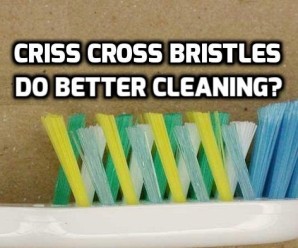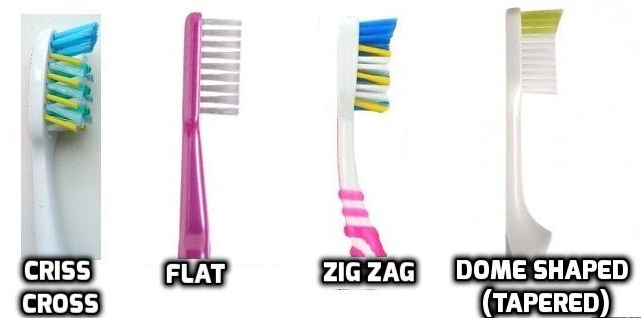
Is a Criss Cross Bristled Toothbrush is Better?
Is a criss cross bristled toothbrush is better than a flat trimmed one?
Logically, it seems true because angled bristles (in opposite direction) can clean those hard to reach inter-dental areas (area between the teeth) better than flat bristles.
But, various case studies don’t approve this logic straight forwardly. I’ve compiled five case studies published in various medical journals to check the plaque removal efficacy of different bristle designs of manual toothbrushes- flat trimmed, criss cross, zigzag and dome shaped. There is no fixed trend among these case studies.
- Out of five, three case studies concluded that both (criss cross and flat) are equally good.
- One case study observed that criss cross is better than flat trimmed.
- One case study found that flat trimmed one is better.
Thankfully, these case studies do highlight that all the bristle designs can effectively remove the dental plaque if used properly. Hence, if we just keep aside the comparative analysis for a moment, any of the bristle design can give good results if we follow the basic rules of tooth-brushing.
Bristles design is important for manual toothbrushes
Bristles design is more of a point of concern for manual toothbrushes. For electric (powered) toothbrushes, the cleaning mechanism of brush head- rotating or vibrating- is more important. For example, Braun Oral B electric toothbrush has oscillating-rotating brush head and in sonic and ultrasonic toothbrushes, the brush head vibrates as a super high speed. Hence, in this article, we are discussing the effect of bristles design on the performance of manual toothbrushes only.
Case studies- Criss cross vs Flat trimmed vs Zigzag vs Dome shaped
- A case study was conducted by the Faculty of Dentistry, University of Istanbul, Turkey to check if a manual toothbrush with criss crossed bristles is better than flat trimmed one. A total of 40 participants were divided into two groups- one group used criss cross bristled toothbrush and the other used flat one on a daily basis. The plaque removal score was checked after 3 and 6 months. It was observed that both types of toothbrushes were equally in reducing dental plaque and gingivitis.
- A case study reported in the International Journal of Dental Sciences and Research, Issue 6A, 2014 analyzed the performance of 5 different bristle designs and found no significant difference between them in terms of plaque removal efficacy.
- Another case study published in the magazine- Oral Health and Preventive Dentistry, Oct 2012- evaluated the plaque removing ability of three different kinds of manual toothbrushes- flat, criss cross and zigzag- in visually impaired children. After a week of daily brushing, it was observed that criss cross performed slightly better than zigzag and the performance of flat trimmed was quite poor than those two.
- Another case study published in the Journal of the Indian Society of Pedodontics and Preventive Dentistry, Apr-June 2007 evaluated 4 different bristle designs of manual toothbrushes and concluded that all of them possess equal plaque removing ability.
- One more case study published in the Journal of University Medical and Dental College, Faisalabad, Pakistan, Jan-Mar 2015 observed that the plaque removing efficacy of flat, zigzag and dome shaped bristles were comparable to each other while the criss cross bristled toothbrush performed poorly than the rest.
Here, we can see that there is no fixed trend of results. In three case studies, criss cross bristled toothbrush performed at par with other bristle designs and in remaining two, it either outperforms the flat trimmed one or under-perform than that.
Hence, certainly, we need to rule out the impact of bristle design in the plaque reducing efficacy of a manual toothbrush.
Going beyond the bristle design
According to the American Dental Association, choose a toothbrush with soft bristles that fits your mouth well and easy to use. Manual and electric- both types of toothbrushes can do the job well if used properly. If you are dealing with dexterity (brushing difficulties) such as arthritis, mental disability, vision impairment- then an electric toothbrush would be better.
The bristles design doesn’t get any special attention from any recognized professional body of dentists across the world. But, yes…logically a criss cross bristled toothbrush should perform better in cleaning the hard to reach areas of your mouth.
Keeping aside the impact of bristles design, let us summarize the basic rules of tooth-brushing:
- Brush daily twice a day for two minutes each followed by tongue cleaning and flossing.
- Always use a toothbrush with soft bristles, small head and non slippery grip. Small headed toothbrushes can clean the difficult to reach areas of your mouth more effectively.
- Don’t brush haphazardly. Place the toothbrush at 45 degree angle against the gum line and slowly move it back and forth. Don’t put too much pressure and just focus on one to two teeth at a time. Give extra attention to back teeth and those hard to reach areas.
- Change your toothbrush every 3 months or sooner if it shows the symptoms of getting worn out- bristles discoloration, fuzziness or missing bristles.
- Rinse your toothbrush thoroughly after use and store it in an upright position that allows the bristles to air dry.
- If there are more than one toothbrush in the holder, keep the bristles separate. Bristles of two or more toothbrushes should not touch each other as it can result in the transfer of oral bacteria.
- Visit your dentist twice a year for routine checkup.
Conclusion
Bristles design of a toothbrush doesn’t seem to have much impact on the plaque removing ability of a toothbrush. In future, more case studies with bigger sample size (number of volunteers) and longer time duration would be helpful in drawing a concrete comparison.
Hence, just choose a toothbrush of a reputed brand that has soft bristles and fits your mouth well for better oral health.
From where to buy
You may check this criss cross bristled manual toothbrush from Oral B at Amazon. It has good user reviews and seems an economical option.
If you are from USA, click here
If you are from UK, click here
If you are from India, click here
Read more
Tips for choosing a good toothbrush
References
https://www.ncbi.nlm.nih.gov/pmc/articles/PMC4144140/
https://www.ncbi.nlm.nih.gov/pubmed/23094264
https://www.ncbi.nlm.nih.gov/pubmed/17660641
https://jumdc.tuf.edu.pk/articles/volume-6-1/(41-47)%20151.pdf
http://pubs.sciepub.com/ijdsr/2/6A/4/




